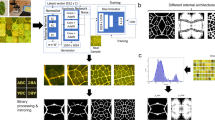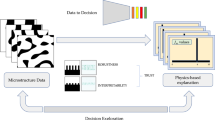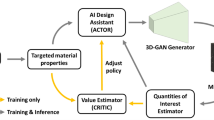Abstract
The problem of the efficient design of material microstructures exhibiting desired properties spans a variety of engineering and science applications. The ability to rapidly generate microstructures that exhibit user-specified property distributions can transform the iterative process of traditional microstructure-sensitive design. We reformulate the microstructure design process using a constrained generative adversarial network (GAN) model. This approach explicitly encodes invariance constraints within GANs to generate two-phase morphologies for photovoltaic applications obeying design specifications: specifically, user-defined short-circuit current density and fill factor combinations. Such invariance constraints can be represented by differentiable, deep learning-based surrogates of full physics models mapping microstructures to photovoltaic properties. Furthermore, we propose a multi-fidelity surrogate that reduces expensive label requirements by a factor of five. Our framework enables the incorporation of expensive or non-differentiable constraints for the fast generation of microstructures (in 190 ms) with user-defined properties. Such proposed physics-aware data-driven methods for inverse design problems can be used to considerably accelerate the field of microstructure-sensitive design.
This is a preview of subscription content, access via your institution
Access options
Access Nature and 54 other Nature Portfolio journals
Get Nature+, our best-value online-access subscription
$29.99 / 30 days
cancel any time
Subscribe to this journal
Receive 12 digital issues and online access to articles
$99.00 per year
only $8.25 per issue
Buy this article
- Purchase on Springer Link
- Instant access to full article PDF
Prices may be subject to local taxes which are calculated during checkout




Similar content being viewed by others
Code availability
The codes for generating the dataset is available in the following code repository45. The data and code used to train the models are available in a code capsule46 and the code used to generate the figures and results of this study is available in a separate code capsule47. Source data are provided with this paper.
References
Anthony, J. E. Addressing challenges. Nat. Mater. 13, 773–775 (2014).
Yao, H.-B. et al. A flexible and highly pressure-sensitive graphene–polyurethane sponge based on fractured microstructure design. Adv. Mater. 25, 6692–6698 (2013).
Du, P., Zebrowski, A., Zola, J., Ganapathysubramanian, B. & Wodo, O. Microstructure design using graphs. NPJ Comput. Mater. 4, 50 (2018).
Noruzi, R., Ghadai, S., Bingol, O. R., Krishnamurthy, A. & Ganapathysubramanian, B. NURBS-based microstructure design for organic photovoltaics. Comput. Des. 118, 102771 (2020).
Pokuri, B. S. S., Ghosal, S., Kokate, A., Sarkar, S. & Ganapathysubramanian, B. Interpretable deep learning for guided microstructure–property explorations in photovoltaics. NPJ Comput. Mater. 5, 95 (2019).
Stoecklein, D., Lore, K. G., Davies, M., Sarkar, S. & Ganapathysubramanian, B. Deep learning for flow sculpting: insights into efficient learning using scientific simulation data. Sci. Rep. 7, 46368 (2017).
Lore, K. G., Stoecklein, D., Davies, M., Ganapathysubramanian, B. & Sarkar, S. A deep learning framework for causal shape transformation. Neural Netw. 98, 305–317 (2018).
Bock, F. E. et al. A review of the application of machine learning and data mining approaches in continuum materials mechanics. Front. Mater. 6, 110 (2019).
Lee, X. Y., Balu, A., Stoecklein, D., Ganapathysubramanian, B. & Sarkar, S. A case study of deep reinforcement learning for engineering design: application to microfluidic devices for flow sculpting. J. Mech. Des. 141, 111401 (2019).
Balu, A. et al. A deep learning framework for design and analysis of surgical bioprosthetic heart valves. Sci. Rep. 9, 18560 (2019).
Geng, Y., van Anders, G., Dodd, P. M., Dshemuchadse, J. & Glotzer, S. C. Engineering entropy for the inverse design of colloidal crystals from hard shapes. Sci. Adv. 5, eaaw0514 (2019).
Kim, B., Lee, S. & Kim, J. Inverse design of porous materials using artificial neural networks. Sci. Adv. 6, eaax9324 (2020).
Goodfellow, I. et al. Generative adversarial nets. In Advances in Neural Information Processing Systems 2672–2680 (NIPS, 2014).
Yang, L., Zhang, D. & Karniadakis, G. E. Physics-informed generative adversarial networks for stochastic differential equations. SIAM J. Sci. Comput. 42, A292–A317 (2020).
de Oliveira, L., Paganini, M. & Nachman, B. Learning particle physics by example: location-aware generative adversarial networks for physics synthesis. Comput. Softw. Big Sci. 1, 4 (2017).
Wu, J.-L. et al. Enforcing statistical constraints in generative adversarial networks for modeling chaotic dynamical systems. J. Comput. Phys. 406, 109209 (2020).
Yang, Z. et al. Microstructural materials design via deep adversarial learning methodology. J. Mech. Des. 140, 111416 (2018).
Sanchez-Lengeling, B. & Aspuru-Guzik, A. Inverse molecular design using machine learning: generative models for matter engineering. Science 361, 360–365 (2018).
Prykhodko, O. et al. A de novo molecular generation method using latent vector based generative adversarial network. J. Cheminform. 11, 74 (2019).
Fokina, D., Muravleva, E., Ovchinnikov, G. & Oseledets, I. Microstructure synthesis using style-based generative adversarial networks. Phys. Rev. E 101, 043308 (2020).
Gayon-Lombardo, A., Mosser, L., Brandon, N. P. & Cooper, S. J. Pores for thought: generative adversarial networks for stochastic reconstruction of 3D multi-phase electrode microstructures with periodic boundaries. NPJ Comput. Mater. 6, 82 (2020).
Joshi, A. et al. InvNet: encoding geometric and statistical invariances in deep generative models. In Proc. AAAI Conference on Artificial Intelligence Vol. 34, 4377–4384 (AAAI, 2020).
Yu, G., Gao, J., Hummelen, J. C., Wudl, F. & Heeger, A. J. Polymer photovoltaic cells: enhanced efficiencies via a network of internal donor–acceptor heterojunctions. Science 270, 1789–1791 (1995).
Shaheen, S. E. et al. 2.5% efficient organic plastic solar cells. Appl. Phys. Lett. 78, 841–843 (2001).
Guerrero, A. & Garcia-Belmonte, G. Recent advances to understand morphology stability of organic photovoltaics. Nano Micro Lett. 9, 10 (2017).
Kodali, H. K. & Ganapathysubramanian, B. Computer simulation of heterogeneous polymer photovoltaic devices. Model. Simul. Mater. Sci. Eng. 20, 035015 (2012).
Arjovsky, M., Chintala, S. & Bottou, L. Wasserstein generative adversarial networks. In Proc. 34th International Conference on Machine Learning Vol. 70, 214–223 (PMLR, 2017).
Csáji, B. C. et al. Approximation with Artificial Neural Networks. MSc thesis, Eotvos Loránd Univ. (2001).
Sarkar, S. et al. Multifidelity and multiscale Bayesian framework for high-dimensional engineering design and calibration. J. Mech. Des. 141, 121001 (2019).
Costabal, F. S., Perdikaris, P., Kuhl, E. & Hurtado, D. E. Multi-fidelity classification using Gaussian processes: accelerating the prediction of large-scale computational models. Comput. Methods Appl. Mech. Eng. 357, 112602 (2019).
Babaee, H., Bastidas, C., DeFilippo, M., Chryssostomidis, C. & Karniadakis, G. A multifidelity framework and uncertainty quantification for sea surface temperature in the Massachusetts and Cape Cod Bays. Earth Space Sci. 7, e2019EA000954 (2020).
Meng, X. & Karniadakis, G. E. A composite neural network that learns from multi-fidelity data: application to function approximation and inverse pde problems. J. Comput. Phys. 401, 109020 (2020).
Wodo, O., Zola, J., Pokuri, B. S. S., Du, P. & Ganapathysubramanian, B. Automated, high throughput exploration of process–structure–property relationships using the MapReduce paradigm. Mater. Discov. 1, 21–28 (2015).
Wodo, O., Tirthapura, S., Chaudhary, S. & Ganapathysubramanian, B. Computational characterization of bulk heterojunction nanomorphology. J. Appl. Phys. 112, 064316 (2012).
Balu, A., Ghadai, S., Sarkar, S. & Krishnamurthy, A. Orthogonal distance fields representation for machine-learning based manufacturability analysis. In Proc. ASME 2020 International Design Engineering Technical Conferences and Computers and Information in Engineering Conference V009T09A044 (American Society of Mechanical Engineers, 2020).
Ghadai, S., Balu, A., Sarkar, S. & Krishnamurthy, A. Learning localized features in 3D CAD models for manufacturability analysis of drilled holes. Comput. Aided Geom. Des. 62, 263–275 (2018).
Jagatap, G. & Hegde, C. Algorithmic guarantees for inverse imaging with untrained network priors. In Advances in Neural Information Processing Systems 14832–14842 (NIPS, 2019).
Pfeifer, S., Wodo, O. & Ganapathysubramanian, B. An optimization approach to identify processing pathways for achieving tailored thin film morphologies. Comput. Mater. Sci. 143, 486–496 (2018).
Cahn, J. W. & Hilliard, J. E. Free energy of a nonuniform system. I. Interfacial free energy. J. Chem. Phys. 28, 258–267 (1958).
Shah, V. et al. Binary 2D morphologies of polymer phase separation: dataset and Python toolbox (2019); https://doi.org/10.5281/zenodo.2580293
Wodo, O. & Ganapathysubramanian, B. Modeling morphology evolution during solvent-based fabrication of organic solar cells. Comput. Mater. Sci. 55, 113–126 (2012).
Wodo, O. & Ganapathysubramanian, B. Computationally efficient solution to the Cahn–Hilliard equation: adaptive implicit time schemes, mesh sensitivity analysis and the 3D isoperimetric problem. J. Comput. Phys. 230, 6037–6060 (2011).
Gulrajani, I., Ahmed, F., Arjovsky, M., Dumoulin, V. & Courville, A. C. Improved training of Wasserstein GANs. In Advances in Neural Information Processing Systems 5767–5777 (NIPS, 2017).
Pokuri, B. S. S. et al. Binary 2D morphologies of polymer phase separation, https://doi.org/10.5281/zenodo.2580293 (2019).
Balaji. pbssarath/excitonic_drift_diffusion: v1.0, https://doi.org/10.5281/zenodo.4552777 (2021).
Lee, X. Y. et al. Fast inverse design of microstructures via generative invariance networks (training) (2021); https://www.codeocean.com/, https://doi.org/10.24433/CO.1250930.v1
Lee, X. Y. et al. Fast inverse design of microstructures via generative invariance networks (evaluation and figures) (2021); https://www.codeocean.com/, https://doi.org/10.24433/CO.3688453.v1
Acknowledgements
This work was supported by the ARPA-E DIFFERENTIATE programme under grant no. DE-AR0001215. B.G., C.-H.Y. and B.S.S.P. were supported in part by DoD MURI 6119-ISU-ONR-2453. C.H. and A.J. were supported in part by NSF grants CCF-2005804 and CCF-1815101. We thank A. Krishnamurthy and Z. Bao for fruitful discussions and constructive suggestions. Computing support from XSEDE and Iowa State University is also gratefully acknowledged.
Author information
Authors and Affiliations
Contributions
C.H., B.G. and S.S. initiated the project; B.S.S.P. and B.G. planned and generated the dataset. X.Y.L., A.J., C.H., B.G. and S.S. designed the machine learning framework. X.Y.L., J.R.W. and C.-H.Y. performed the training. X.Y.L., A.J. and A.B. analyzed the data. All authors contributed to writing the manuscript.
Corresponding authors
Ethics declarations
Competing interests
The authors declare no competing interests.
Additional information
Peer review information Nature Computational Science thanks Samuel Cooper and the other, anonymous, reviewer(s) for their contribution to the peer review of this work. Jie Pan was the primary editor on this article and managed its editorial process and peer review in collaboration with the rest of the editorial team.
Publisher’s note Springer Nature remains neutral with regard to jurisdictional claims in published maps and institutional affiliations.
Supplementary information
Supplementary Information
Supplementary Information, Discussion, Figs. 1–9 and Tables 1–7.
Source data
Source Data Fig. 2
Statistical source data to generate correlation and error density plots.
Source Data Fig. 3
Image of generated microstructures and statistical source data to generate density plots.
Source Data Fig. 4
Image of generated microstructures and statistical source data to generate density plots.
Rights and permissions
About this article
Cite this article
Lee, X.Y., Waite, J.R., Yang, CH. et al. Fast inverse design of microstructures via generative invariance networks. Nat Comput Sci 1, 229–238 (2021). https://doi.org/10.1038/s43588-021-00045-8
Received:
Accepted:
Published:
Issue Date:
DOI: https://doi.org/10.1038/s43588-021-00045-8
This article is cited by
-
Interpretable learning of voltage for electrode design of multivalent metal-ion batteries
npj Computational Materials (2022)
-
Self-supervised optimization of random material microstructures in the small-data regime
npj Computational Materials (2022)
-
Inverse design of anisotropic spinodoid materials with prescribed diffusivity
Scientific Reports (2022)
-
Dynamical phase-field model of coupled electronic and structural processes
npj Computational Materials (2022)
-
A framework for data-driven solution and parameter estimation of PDEs using conditional generative adversarial networks
Nature Computational Science (2021)



